
Graphic cameras, from Graflex, are the “press camera” par excellence. In any picture or movie from the 30 to 50’s, whenever you see a gathering of photo reporters, forming a front line and waiting for any special event or celebrity to show up, you will always find many of them holding a Speed Graphic with a big flashbulb reflector. For us today, it looks like a very cumbersome camera to be used in situations requiring agility. But we have to consider, in first place, that large format films were still top of mind for professionals and probably they didn’t feel like going to the field with a miniature camera probably seen as amateurs’. Another point to bear in mind is that using a big and powerful flashbulb like the nº 11, picture above, and a Super XX film, ASA 100, maybe with push development, a photographer could easily work with f11 or f16 and that provided a generous depth of field. On top of that, the use of a mid wide angle lens, like the Optar 135 mm, or a Ektar 127 mm, guaranteed the inclusion of a large portion of the scene in the picture and the possibility of getting very close to subject. To complete, a 4×5″ negative allowed a lot of room for cropping and reframing without loosing too much quality. That is why we see press photographers from those years just concentrated in the right moment with a handheld camera, looking through the wire frame finder and not bothering with focus, speed, aperture or any other adjustment. The Graphic camera can be as quick as a point and shoot if you train yourself and think before hand what you intend to do. Only the size, for that there is no remedy.

Weegee (on the left) is probably the most famous user and enthusiast of Graphic cameras. Real name was Arthur (Usher) Fellig (1899–1968). An emigrant from Ukraine, became a photojournalist working in Manhattan in the years 30/40’s. His ability to get to the crime scene, fire or whatever news headline event, before any other and quickly snap story telling images, became a legend and granted him the right to credit his pictures as “Weegee the famous”.
It is interesting to think that at the same time, Henri Cartier Bresson, French, was using his tiny Leica, 35 mm, and setting the standard for another kind of snap shot. While Bresson was quiet and sneak, in seising his images, Weegee probably took pleasure from the flare that certified his subjects that yes, they were caught. It is like comparing a pickpocket with an armed robber.
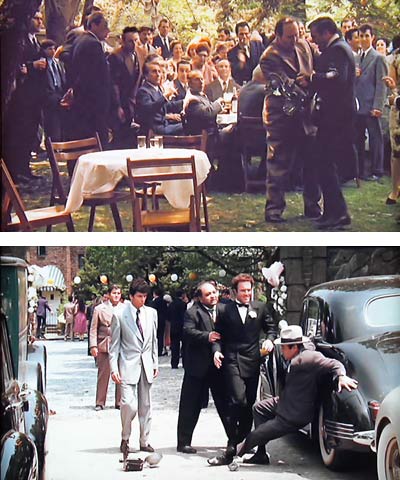
The indiscretion of the Graphic Graflex is well illustrated in The Godfather, from Francis Ford Coppola, 1972. It is not a good idea to try “stolen” photos with this camera. But in the movie, a photographer out of habit tempts some records about the joyful Mafia’s life, during the Godfather’s daughter’s wedding, using a Graflex 4 x 5 with flashbulbs and everything. It ends up badly. First his film is torn and still jammed with everyone watching with an air of “who is this guy?”. Soon after, still trying a few clicks, he is put out of the party and still have the camera destroyed by the bride’s brother. Holding on to keep from falling, he looks at the remains of his camera thrown to the ground. At that time, maybe he was considering that it would be better to come with a Minox.
Difference between Crown Graphic and Speed Graphic
The first Graphic was the Speed Graphic, it was featured with two shutters, a leaf-shutter built in the lens, and a focal plane shutter on camera’s back. Speed Graphics exist since 1912, but in 1947 Graflex realised that most of the time photographers did not use the focal plane shutter and then took it off launching the Crown Graphic, lighter and shorter. The difference can be seen on the picture below. While the front is the same, the sides of the cameras are different. Crown Graphic does not show the shutter cocking knob and it is shorter in length.
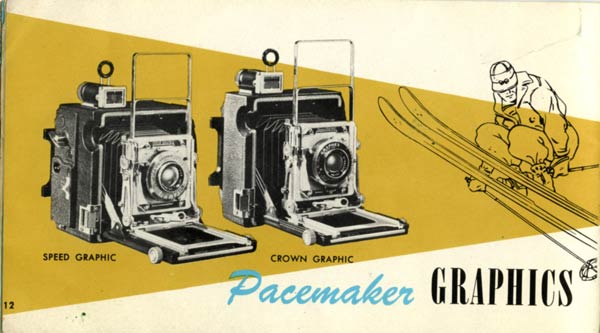
Also a view camera
Beyond hand held and action photography, using wire frame finder or optical tube viewfinder and rangefinder, one can set a Graphic on a tripod and use the ground glass for any sort of precision photography, from portraits to scientific research. To support that, the camera allow for some lens movements: front rise, tilt and shift. But there is no revolving or moving back and lens board is still a bit small to allow a wider choice of lenses. For studio work in general it falls short compared to a Linhof Technika, which is also a drop bed press camera (much heavier than Graflexes)
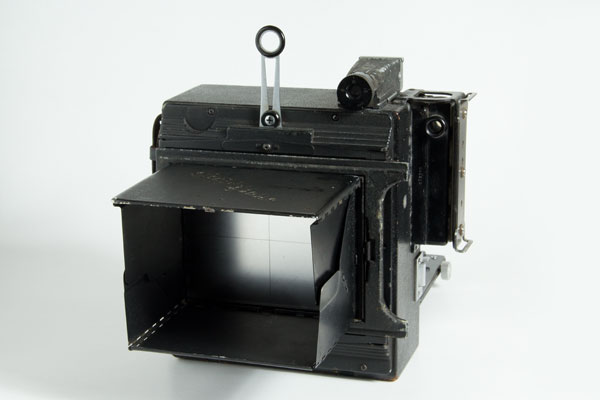
Film holders are interchangeable with most of other brands like Linhof. The standard 4×5″ has the same external shape as the European 9×12 cm. One has only to be careful in noting that what he sees in the ground glass will be cropped on borders when using smaller 9x12cm.
Above is the spring back. In which you can insert film holders without the need of removing ground glass. Even better is the Graflok back that allow the same and yet can be easily removed if you want to insert a 120 roll film adapter.
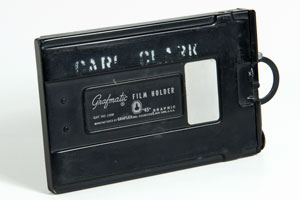
A very nice accessory, specially for hand held photography, is the Grafmatic film holder. You can load it with 6 sheet. To advance from an exposed film sheet to a fresh one it is almost as quick as advancing a roll film. It is a mechanism like a drawer that sends the exposed sheet to the back and sets a fresh one in place.


It all can be conveniently stored in an original case that today does not look a all like having a photographic camera inside.
Choice of lenses is compatible with a 4×5″ press camera, the bed drops to a second click beyond 90º in order to fit wide angle lenses and avoiding the lens track showing up in the picture. That is a must with a 65 mm lens. Also longer focal lengths can be used as bellows extends up to 312 mm (12 ½”). A 240 mm lens is possible if very near focus is not needed. But the Graphics are so much linked with press photography, or hand held photography better saying, that it is probably not a camera for those aiming to use a variety of focal lengths. Below is a W.A. (it stands for Wide Angle) f 6.8 – 90 mm Optar. Being W.A. means that it also allows for lens movements as it covers more than 4×5″.
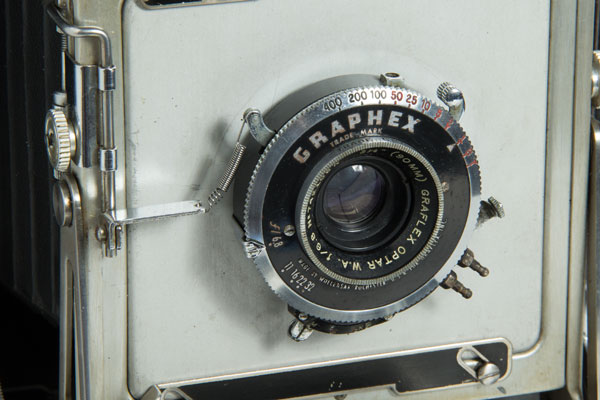
There is a lot of literature and web resources about Graflex Graphic cameras. In special, graflex.org, is a wonderful source of information. One book that is not that hard to find and really worth looking into is Graphic Graflex Photography. It covers all technicalities, including lighting and darkroom, and yet gives a good view of photography itself at those times. It was published in 1948 with many contributors and covers an amazing variety of genres and situations where, they say, the Graphics are the best option.
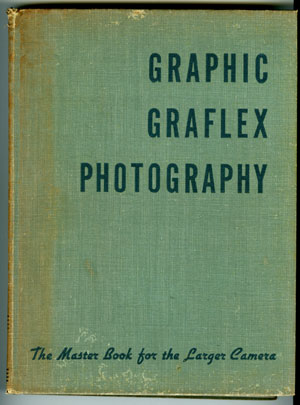
Double page advertising U.S. Camera, 1947.
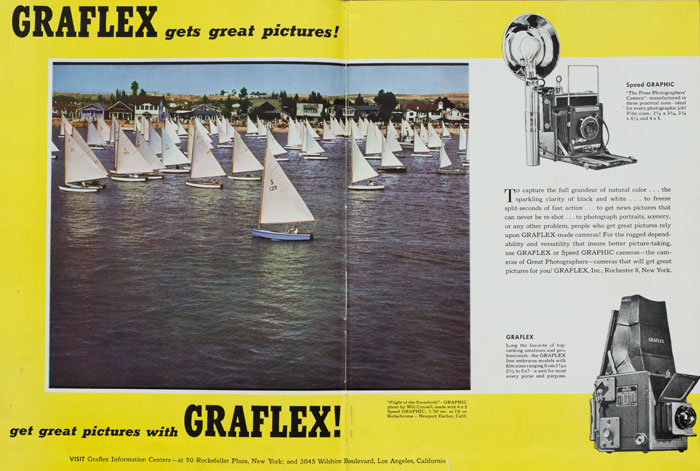
Graphics remained in production until 1973 but already in the late 50’s it started to be overcome by Rolleiflex as a press and all purpose camera. This one featured in this post was produced between 1947, date of Crown Graphic launch, and 1955, when the side rangefinder moved to the top of the camera to be coupled with viewfinder. Below is a picture from an advertisement for electronic flash from Sylvania.

Some pictures made with this Crown Graphic, all of them with the 135 mm Optar. First one was hand-held with a GE nº 5 flash bulb.



